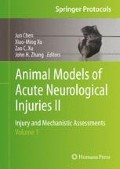Abstract
Cerebral vasospasm is chiefly due to sustained abnormal contraction of smooth muscle cells. Vasospasm develops several days after subarachnoid hemorrhage (SAH) and resolves after 10–14 days. Electrophysiological techniques have been used by several laboratories to elucidate some of the mechanisms involved in experimental vasospasm, including roles of calcium, potassium and transient receptor potential (TRP) channels. The purpose of this chapter is to briefly introduce the instrumentation, materials and procedures for using electrophysiology techniques to study the functional role of ion channels and receptors in smooth muscle cells or potentially other neuronal cells in the brain that may mediate vasospasm and/or brain dysfunction after SAH.
Access this chapter
Tax calculation will be finalised at checkout
Purchases are for personal use only
References
Jahromi BS, Aihara Y, Ai J, Zhang ZD, Weyer G, Nikitina E, Yassari R, Houamed KM, Macdonald RL (2008) Temporal profile of potassium channel dysfunction in cerebrovascular smooth muscle after experimental subarachnoid haemorrhage. Neurosci Lett 440:81–86
Jahromi BS, Aihara Y, Ai J, Zhang ZD, Nikitina E, Macdonald RL (2008) Voltage-gated K+ channel dysfunction in myocytes from a dog model of subarachnoid hemorrhage. J Cereb Blood Flow Metab 28:797–811
Jahromi BS, Aihara Y, Ai J, Zhang ZD, Weyer G, Nikitina E, Yassari R, Houamed KM, Macdonald RL (2008) Preserved BK channel function in vasospastic myocytes from a dog model of subarachnoid hemorrhage. J Vasc Res 45: 402–415
Nikitina E, Kawashima A, Takahashi M, Zhang ZD, Shang X, Ai J, Macdonald RL (2010) Alteration in voltage-dependent calcium channels in dog basilar artery after subarachnoid hemorrhage. Laboratory investigation. J Neurosurg 113:870–880
Koide M, Penar PL, Tranmer BI, Wellman GC (2007) Heparin-binding EGF-like growth factor mediates oxyhemoglobin-induced suppression of voltage-dependent potassium channels in rabbit cerebral artery myocytes. Am J Physiol Heart Circ Physiol 293:H1750–H1759
Xie A, Aihara Y, Bouryi VA, Nikitina E, Jahromi BS, Zhang ZD, Takahashi M, Macdonald RL (2007) Novel mechanism of endothelin-1-induced vasospasm after subarachnoid hemorrhage. J Cereb Blood Flow Metab 27:1692–1701
Weyer GW, Jahromi BS, Aihara Y, Agbaje-Williams M, Nikitina E, Zhang ZD, Macdonald RL (2006) Expression and function of inwardly rectifying potassium channels after experimental subarachnoid hemorrhage. J Cereb Blood Flow Metab 26:382–391
Ishiguro M, Wellman TL, Honda A, Russell SR, Tranmer BI, Wellman GC (2005) Emergence of a R-type Ca2+ channel (CaV 2.3) contributes to cerebral artery constriction after subarachnoid hemorrhage. Circ Res 96:419–426
Ishiguro M, Morielli AD, Zvarova K, Tranmer BI, Penar PL, Wellman GC (2006) Oxyhemoglobin-induced suppression of voltage-dependent K+ channels in cerebral arteries by enhanced tyrosine kinase activity. Circ Res 99: 1252–1260
Wellman GC (2006) Ion channels and calcium signaling in cerebral arteries following subarachnoid hemorrhage. Neurol Res 28:690–702
Sakmann B, Neher E (1984) Patch clamp techniques for studying ionic channels in excitable membranes. Annu Rev Physiol 46:455–472
Hille B (2001) Ion channels of excitable membranes. Sinauer Associates, Sunderland, MA
Stockbridge N, Zhang H, Weir B (1991) Effects of K+ channel agonists cromakalim and pinacidil on rat basilar artery smooth muscle cells are mediated by Ca(++)-activated K+ channels. Biochem Biophys Res Comm 181:172–178
Park CC, Shin ML, Simard JM (1997) The complement membrane attack complex and the bystander effect in cerebral vasospasm. J Neurosurg 87:294–300
Han DH, Bai GY, Yang TK, Sim BS, Kwak YG, Kim CJ (2007) The effect of papaverine on ion channels in rat basilar smooth muscle cells. Neurol Res 29:544–550
Dreier JP, Ebert N, Priller J, Meqow D, Lindauer U, Klee R, Reuter U, Imai Y, Einhaupl KM, Victorov I, Dirnagl U (2000) Products of hemolysis in the subarachnoid space inducing spreading ischemia in the cortex and focal necrosis in rats: a model for delayed ischemic neurological deficits after subarachnoid hemorrhage? J Neurosurg 93:658–666
Petzold GC, Haack S, von Bohlen Und HO, Priller J, Lehmann TN, Heinemann U, Dirnagl U, Dreier JP (2008) Nitric oxide modulates spreading depolarization threshold in the human and rodent cortex. Stroke 39:1292–1299
Pluta RM, Hansen-Schwartz J, Dreier J, Vajkoczy P, Macdonald RL, Nishizawa S, Kasuya H, Wellman G, Keller E, Zauner A, Dorsch N, Clark J, Ono S, Kiris T, Leroux P, Zhang JH (2009) Cerebral vasospasm following subarachnoid hemorrhage: time for a new world of thought. Neurol Res 31:151–158
Mutch WA (2010) New concepts regarding cerebral vasospasm: glial-centric mechanisms. Can J Anaesth 57:479–489
Author information
Authors and Affiliations
Corresponding author
Editor information
Editors and Affiliations
Rights and permissions
Copyright information
© 2012 Springer Science+Business Media, LLC
About this protocol
Cite this protocol
Ai, J., Macdonald, R.L. (2012). Electrophysiological Assessment of Cerebral Vasospasm. In: Chen, J., Xu, XM., Xu, Z., Zhang, J. (eds) Animal Models of Acute Neurological Injuries II. Springer Protocols Handbooks. Humana Press, Totowa, NJ. https://doi.org/10.1007/978-1-61779-576-3_39
Download citation
DOI: https://doi.org/10.1007/978-1-61779-576-3_39
Published:
Publisher Name: Humana Press, Totowa, NJ
Print ISBN: 978-1-61779-575-6
Online ISBN: 978-1-61779-576-3
eBook Packages: Springer Protocols

